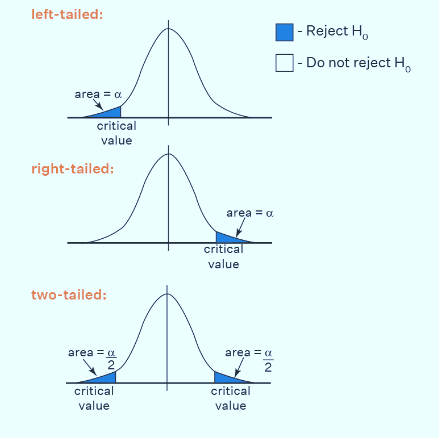 |
| Understanding Critical Values: Explanation & Calculation |
The critical value serves as the
threshold that determines whether we accept or reject the null hypothesis in
hypothesis testing. It's a specific point on a scale beyond which a researcher
would reject the null hypothesis in favor of the alternative hypothesis.
Statisticians compare computed test
statistics with these critical values to perform hypothesis testing. The null
hypothesis is rejected if the computed statistic is greater than the crucial
value since it suggests that the outcome is not likely to have happened by
chance alone.
This article aims to cover how
critical values are calculated, their significance in different statistical
tests; and their practical applications in drawing meaningful conclusions from
data analysis.
(toc)
What is Critical Value?
There are critical values for
various types of hypothesis tests. These values can be interpreted from the
distribution of the test statistic and the significance level. One-tailed hypothesis tests have a single critical
value; while two-tailed tests have two critical values.
Understanding
the Critical Value: A Definition
A critical value is a threshold
value used in hypothesis testing to determine whether the observed results are
likely due to chance or reflect a real effect. It acts as a boundary line that
separates the region of expected results from the region of unexpected
results.
Determination:
·
Depends on two factors:
1.
Significance level (α): The maximum
acceptable probability of rejecting the null hypothesis when it's true (false
positive).
2.
Degrees of freedom: The amount of
information available in the data.
·
Differs depending on the particular type of
statistical test being employed.
Interpretation:
·
If the calculated test statistic falls
beyond the critical value, then the null hypothesis is rejected and indicates a
statistically significant effect.
·
If the test statistic falls within the critical
value range, the null hypothesis remains accepted.
The formula
for Calculating the Critical Value:
The formula for a critical value is
based on the specific type of hypothesis test we’re conducting. Critical values
for hypothesis testing can be calculated from either confidence intervals or
significance levels. Critical value formulas are summarized below.
Determining Critical Values from Confidence
Intervals:
Using the confidence interval, we
can find the critical value
for one and two-tailed tests. Imagine that a 95% confidence level has been
selected for performing a hypothesis test. The critical value can be calculated
as follows:
1. Take
100% and deduct the chosen (95%) confidence level.
2. Transform
this value into decimals to obtain the value of α.
3. The
alpha level remains unchanged from the previous step for a one-tailed test.
4. The
alpha level is halved in the case of a two-tailed test.
5. The
critical value can be found by referencing the suitable distribution table
based on the alpha value which varies according to the type of test performed.
Note:
- The detailed procedure for step 4 will be explained
in the following sections.
Classification of critical value:
We've categorized critical values
into three fundamental types that rely on the statistical
test being conducted. Here are these primary types:
1. T
– Critical value
2. Z
– Critical value
3. F
– Critical value
1.
T – Critical Value:
A t-test is applied in situations where the S.D
(Standard deviation) of the population is unknown and the sample size is below
30. A t-test is performed when the population data follows a student’s
t-distribution. The critical value for t can be computed in the following
manner:
Step 1: Establish the α
(level of significance).
Step 2: Deduct one from the
size of the sample. This provides the value for degrees of freedom (df).
Step 3: If the hypothesis
test aims at a particular direction, then refer to the one-tailed
t-distribution table. In situations where the test extends both directions then
refer to the two-tailed t - t-distribution table.
Step 4: Find the
intersection between the degrees of freedom (displayed on the left side) and
the alpha value (shown on the top row) in the table and that is the critical
value.
The test statistic for a
one-sample t-test is calculated as:
t =
(x̄ - μ) / (s / √n)
Where:
·
x̄ is the sample mean
·
μ denoted the population mean.
·
s is the sample standard deviation
·
n is the sample size
The test statistic for a
two-sample t-test: (x̄1 - x̄2) – (μ1- μ2)
/ √ (s₁²/n₁ + s₂²/n₂).
Decision-Making
Criteria:
·
If the test statistic is greater than the t
critical value (for a right-tailed hypothesis test) then reject the null
hypothesis.
·
If the test statistic is less than the critical
value (for a left-tailed hypothesis test) then reject the null hypothesis.
· Reject the null hypothesis if the test statistic falls outside the acceptance region in a two-tailed hypothesis test.
This decision criteria applies
universally to all tests. Only the test statistic and critical value vary
depending on the specific test.
1.
Z – Critical value:
The z-test is used when the
population standard deviation is known and the sample size is large (usually n
> 30). The critical value of Z can be computed in the following manner:
·
Compute the level of α.
·
Deduct the level of α from one for a 2-tailed
test. Deduct the level of alpha from 0.5 for the 1-tailed test.
·
Finding the area in the z distribution table
will yield the z critical value. After the computation, the critical value for
a left-tailed test must have a negative sign appended to it.
The Formula for one Sample Z
test: z = (x̄ - μ) / (σ / √n)
The Formula for two Sample Z
test: z = x̄1 - x̄2) – (μ1- μ2)
/ √ (σ12/n₁ + σ22/n₂).
2.
F – Critical value:
The F test is used for both
variance comparison and regression analysis. The F critical value is computed
as follows:
·
Set the level of alpha.
·
Minus one from the number of observations in the
first sample gives you the first degree of freedom. Let's call it x.
·
Minus one from the 2nd sample size to
take the second degree of freedom. Let’s call it y.
·
With the f-distribution table, locate the cell
where the column labeled with x and the row labeled with y intersect. This cell
will contain the critical value of f.
Calculation of Critical Value:
Example
A researcher wants to assess if the
average score of students on a test is higher than 75. A sample of 20 students
has a mean score of 78 with a standard deviation of 5. The significance level
(α) chosen is 0.05.
Solution:
Step 1:
Establish α = 0.05.
Step 2:
Degrees of freedom (df) = 20 - 1 =
19.
Step 3:
For a one-tailed test, refer to the
t-distribution table. Critical t-value (for α = 0.05 and df = 19) ≈ 1.729.
Test statistic calculation: t = (78
- 75) / (5 / √20) ≈ 3 / 1.12 ≈ 2.68
Decision:
The calculated t-value (2.68) > critical
value (1.729), indicates sufficient evidence to reject the null hypothesis that
the average score is not greater than 75.
Conclusion:
This article explored the critical value of hypothesis testing, its definition, and its role in different statistical tests. We learned how to calculate critical values for various scenarios and how they help us make decisions about rejecting or accepting the null hypothesis.




Comment Below, Ask Anything About This Article...:)